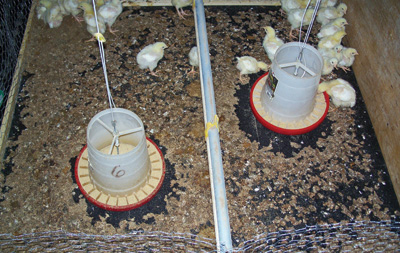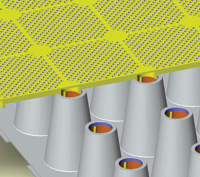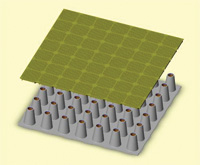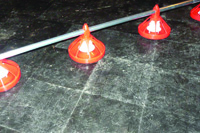
Plastic Underfoot
By Tony Kryzanowski
Features Manure Management ProductionNew flooring system curbs ammonia
Industry, government and researchers in the United States are
co-operating on a project to design “the poultry house of the future,”
and two outcomes could be virtual elimination of ammonia emissions from
poultry barns and a whole new and more effective manure management
situation for poultry producers.
New flooring system curbs ammonia
 |
Industry, government and researchers in the United States are co-operating on a project to design “the poultry house of the future,” and two outcomes could be virtual elimination of ammonia emissions from poultry barns and a whole new and more effective manure management situation for poultry producers.
American producers are strongly motivated to develop workable and affordable solutions because of imminent Environmental Protection Agency (EPA) regulations they expect will require a large reduction of ammonia emissions from poultry barns. Ammonia emission control is also problematic for Canadian poultry producers and some jurisdictions are already taking action to improve air quality in confined feeding operations (CFOs).
 |
|
| Industry, government and researchers in the U. S. are co-operating on a project to design the poultry barn of the future that could virtually eliminate ammonia emissions and result in more effective manure management.
|
|
 |
|
| Few likely thought of using plastic for the floor of their poultry barn, but U.S. studies indicate it may be worthy of serious consideration. |
For example, the Clean Air Strategic Alliance (CASA) has announced a 10-point plan to address air emissions from CFOs in Alberta. Members of CASA’s confined feeding operations project team have committed to support and implement recommendations on monitoring, research and managing emissions between 2008 and 2011. Ammonia is on CASA’s list of priority substances requiring better control.
Designing the ‘barn of the future’
American research on the poultry barn of the future project is being conducted at the University of Maryland Eastern Shore (UMES) campus, which seems appropriate considering the high percentage of poultry operations located in that area of the northeastern United States. That area of the US, taking in east Maryland, Delaware, and eastern Virginia, produces about 600 million broiler chickens annually, or about nine per cent of American production.
The objective of the UMES project is to provide industry with poultry barn design improvements that address a variety of challenges, taking particular aim at flooring, heating, managing relative humidity, and growing birds with multiple ages on the same farm.
A key aspect to the research is a new plastic flooring and ventilation system designed by an engineering firm, AviHome LLC, located in Salisbury, Md., and results so far are better than expected.
The flooring system
The flooring system consists of plastic interlocking squares, measuring about 18 inches by 18 inches. It sits about three inches off the ground, and is supported by peg legs located on the corners of each plastic section. There are tiny holes in each section. Coupled with a ventilation system, air funneling through the holes results in drying of the chicken fecal matter.
“Because of the ventilation and the wicking ability of the water through the fecal material, the newer material on top of the old continues to dry,” says UMES researcher and project leader, Dr. Jeannine Harter-Dennis. A major focus of the UMES research is how to ventilate a poultry barn correctly when using this flooring system to achieved lower moisture content.
The plastic flooring system is sturdy enough to allow equipment to be driven on it so the manure can be scraped away between growing cycles.
No litter is required with this flooring system, and moisture content in the chicken excrement was reduced to as low as 20 per cent in some cases, versus the normal 35 to 40 per cent. Moisture is a key ingredient in the production of ammonia gas, and moist, nitrogen-rich, poultry barn litter is ideal for growing the bacteria that are critical in the production of ammonia.
 |
|
| The flooring system consists of interlocking plastic squares, that sit about three inches off the ground, and are supported by peg legs located on the corners of each plastic section. A ventilation system funnels air through holes in the squares, drying off the chicken fecal matter.
|
Less moisture, fewer bacterial
Reduce the moisture and bacterial growth is greatly reduced, resulting in less ammonia production. Less ammonia also solves the perpetual problem of odour emissions from conventional poultry barns. Right now, the U.S. poultry industry handles the ammonia problem by applying an acidic product to the litter between production cycles to lower the pH in the litter, as this acts as an inhibitor.
“When chickens were grown in an environment with the new flooring and ventilation system, our preliminary results show that the ammonia was totally eliminated,” says Harter-Dennis. “I’m very pleased about that because when the fecal material hits the ground, it dries very rapidly and the lack of litter keeps the pH down below seven most times.” They’ve also witnessed between a 5 to 15 per cent growth improvement in the chickens.
Lower moisture content and pH also results in better disease control, as optimum bacterial growth is in the 8 to 8.5 pH range. This has huge implications for improving the bottom lines of U.S. producers with very little additional capital investment required.
Multiple age flocks?
Right now, Harter-Dennis says poultry production in the U.S. is an “all in, all out” process.
“The reason we do this is for disease control,” she says. “It’s to make sure you don’t have older birds on the same farm as younger birds that could actually transfer diseases.”
Because there is less potential for disease transfer with the new flooring and ventilation system, producers will be able to establish nursery units on the same production land base, as opposed to the current practice of only allowing birds of the same age in the poultry barn.
“If our system works, we will at least and hopefully be successful at growing multiple age birds on the same farm,” she says, “because our disease load is so much lower. Doing the calculations, it almost will allow us to raise twice as many birds on the same land as what we had before.”
However, she acknowledged that there are some design challenges related to material falling through the holes in the plastic flooring onto the floor below. AviHome is aware of the problem and is working on a solution, looking at a new hole design, or a water permeable layer that could be placed over the flooring.
No need for litter
Currently, U.S. producers use a four to six inch thick layer of wood shavings and sawdust called litter as an absorbent floor material in poultry barns, adopting this practice because these materials were readily available as byproducts of the timber industry. However, that situation has changed.
“Now we cut down trees just to make litter,” says Harter-Dennis. “It’s become a product, it’s expensive, and sometimes hard to get if not impossible. So if we can grow chickens without litter, we save a resource, plus we don’t have the volume of a waste product that we would have if we were still using the wood chips and sawdust.”
The current method to manage the ammonia gas is to exhaust it from the poultry barn. Research has shown that vented ammonia contributes to the formation of particulate matter that through a cascade of events leads to the development of smog. This is why the EPA is looking at air quality and aiming to limit the exhausting of ammonia from intensive farm operations in particular.
A step ahead of government
“If we don’t self-regulate, we’re going to get governmentally regulated for the ammonia emissions,” says Harter-Dennis. “We’ve got people in Washington that don’t know very much about agriculture or animal production in general, making laws for us and we as producers want to be pro-active rather than reactive and present them with something that is reasonable and feasible that won’t destroy the industry.”
The concept is to develop a poultry barn floor and ventilation system that will control emissions that will be acceptable to the EPA, and can be retrofitted into existing poultry barns.
'Environmental House'
The reduction in ammonia production using the new flooring and ventilation system was observed after raising chickens on the plastic flooring on a six-week cycle in what Harter-Dennis described as an “environmental house,” where researchers were able to raise a flock of about 500 chickens in environmentally controlled chambers. They measured such critical items as air input, air output and air quality insofar as the functioning of the flooring and ventilation system was concerned. Their plan is to escalate research to the point where the flooring is actually tested within the next year in an actual, commercial poultry barn.
Print this page